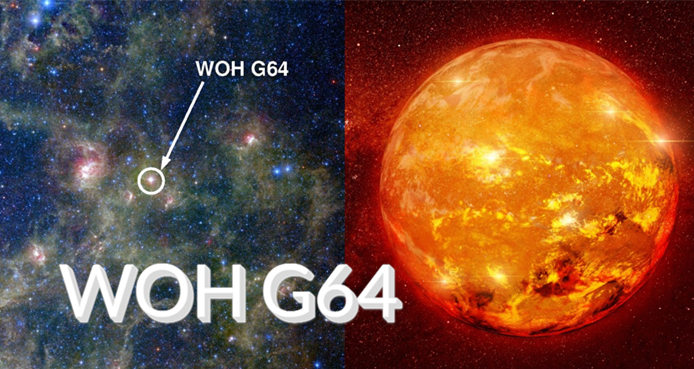In space, 5,100 light years away from Earth, there exists a massive red supergiant star known as the “UY Scuti” in the constellation of Scutum. Astronomers have dubbed this star as the “Galactic Giant,” and UY is currently the largest known star in existence. However, in the satellite galaxy of the Milky Way, the Large Magellanic Cloud, there exists a star even more massive than UY Scuti, and that is WOH G64.
WOH G64 was first observed by Swedish astronomers Bengt Westerlund, Olander and Hedin in 1970s. This star is located approximately 160,000 light years from Earth within the Large Magellanic Cloud. From an Earth-based perspective, WOH G64 is situated near the constellation of Dorado. When compared to Scutum UY, WOH G64 is an absolute giant. Based on the initial data, Scutum UY has a diameter roughly 1,500 times that of the Sun, while WOH G64 has a diameter ranging from 1,550 to 2,575 times that of the Sun. It’s important to note that, in current astronomy, the largest known star has a diameter of approximately 2,500 times that of the Sun.
If WOH G64 truly surpasses this limit, its presence would rewrite the history of human astronomy. If placed within our solar system, it would extend beyond the orbits of the outermost planets. In other words, if this star were to enter our solar system and reach its center, all celestial bodies within the inner solar system, up to Saturn, would be engulfed by this star. When the European Southern Observatory used a large telescope to observe it again, they discovered significant inconsistencies. Initially thought to have a mass about 40 times that of the Sun, it was later found to have such high mass. However, its temperature and brightness did not match its mass.
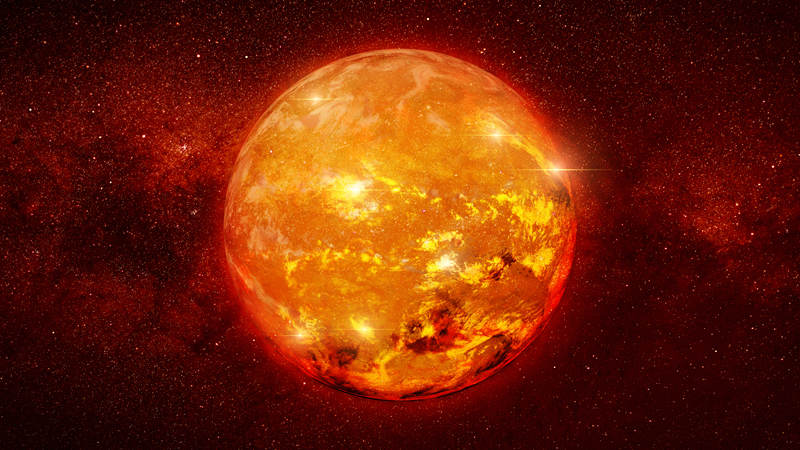
Subsequent measurements revealed the presence of a massive circumstellar envelope around the star. The mass of this envelope is estimated to be between 3 to 9 times that of the Sun, and its thickness extends to approximately one light year. Interestingly, if you were to combine the star’s core with the mass of its expelled cloud, the diameter of this star would far exceed the existing giant star, Scutum UY.
However, due to its immense size and mass, this star has already reached the late stages of its life. It is continuously shedding material outward, and its current diameter is significantly smaller than Scutum UY, measuring about 2.14 billion kilometers. In the future, it will collapse into a black hole under the influence of gravity. When this star undergoes a supernova explosion, the tremendous energy released will completely obliterate its planetary system. It is anticipated that we may very well witness the demise of this supergiant star in the future.
An Astonishing Star
WOH G64 is a star located in the Large Magellanic Cloud, classified as a red hypergiant star, which means it appears as a gigantic red celestial body from the outside. Its distance from Earth is incredibly vast, approximately 160,000 light years away, making it virtually unreachable with our current technological capabilities. In contrast to our Sun, which is a “naked” star, WOH G64 has a surrounding “halo,” but unlike Saturn’s rings, this halo is not made up of small objects; it consists of gases and dust. Scientists were astounded by its size when they first observed this star.
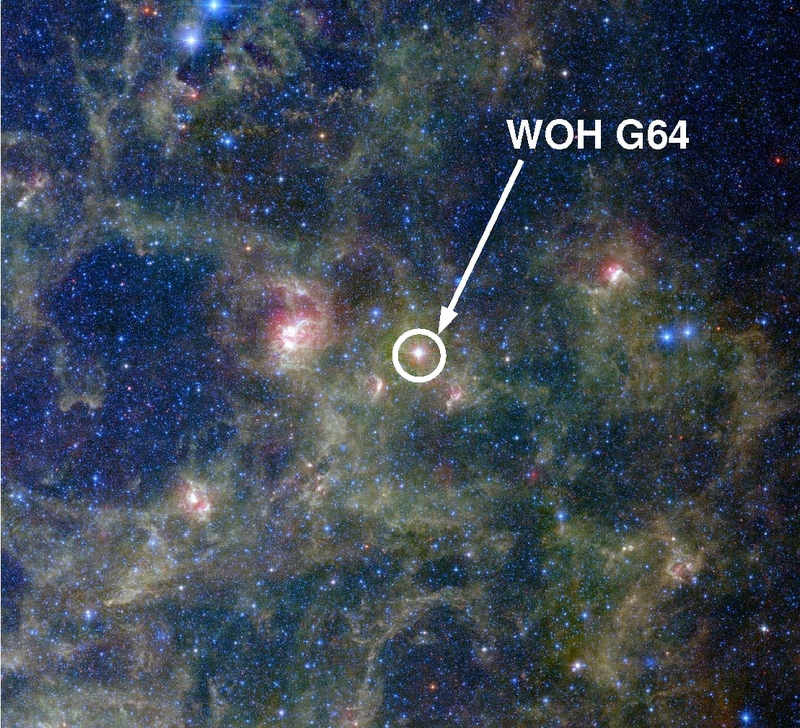
If we include the outer halo, WOH G64’s radius would reach 2,000 times that of the Sun. When compared to the previously mentioned giant stars, this data reveals just how extreme it is. The volume of WOH G64 can be considered 1.7 billion times that of the Sun. If our star were WOH G64 and not the Sun, Earth would no longer exist, as it would have been engulfed by this massive star, even closer to its center. This demonstrates how many mysteries the universe still holds for us, as scientists cannot even determine the status of the largest star we have discovered within the entire cosmos.
The End Point of Gigantic Stars
Although we commonly refer to these celestial objects as stars, they are neither “constant” nor “eternal”; their positions change continuously, and their lifespans naturally shorten. Take the Sun, for instance, which is currently in the main sequence phase, making it a relatively “young” star.
The Sun has been burning in the cosmos for approximately 5 billion years, and as a main sequence star, it has around 5 billion more years to go. After this phase concludes, the Sun won’t extinguish but will transform into a red giant, expanding its volume outward. Ultimately, Earth will face its fate as it gets swallowed by this expanding star. In the red giant state, the Sun will continue to burn its own material until the next stage. Many of the massive stars we find in the universe have already passed through the main sequence stage and are burning in more extravagant ways. WOH G64 is a particularly evident example. Scientists once thought its radius was 2,000 times that of the Sun, but it has now reduced to approximately 1,500 times, as its materials gradually disperse into space.
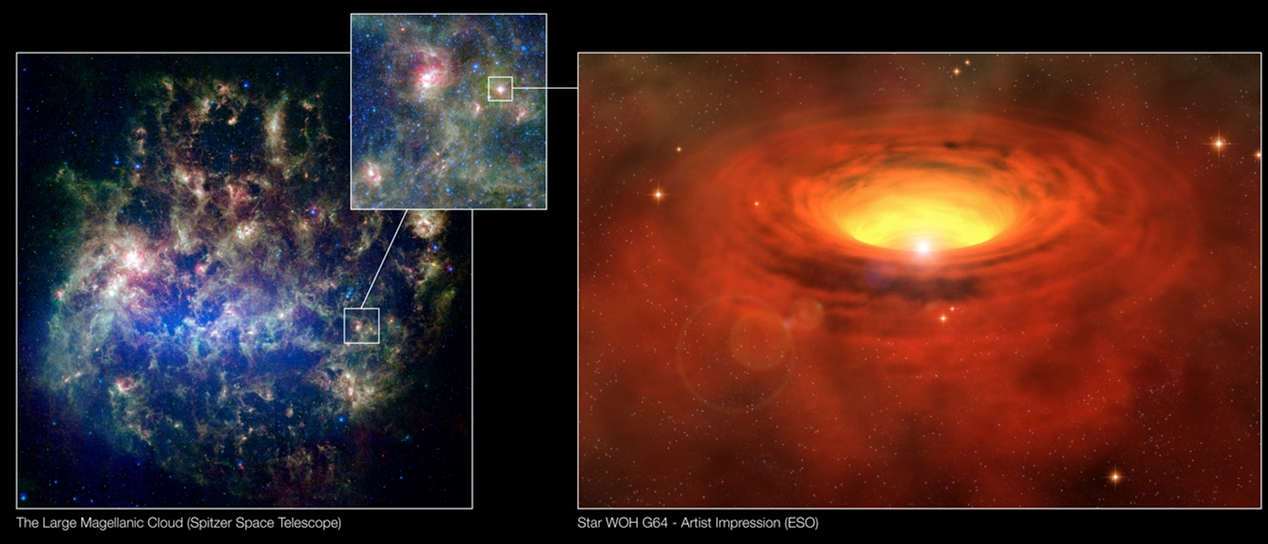
Today, the material emitted by WOH G64 has extended to a thickness of about one light-year, making it increasingly challenging to observe the actual star itself. Nevertheless, according to scientists’ estimations, WOH G64 is likely to have entered the late stages of planetary evolution after the year 2000, leading to a supernova explosion. Different-sized stars have various outcomes after a supernova explosion, but for a star as massive as WOH G64, its fate is likely one: it will become a black hole. Black holes are the most gravitationally powerful entities in the universe, and we cannot visually observe the black hole itself. However, we can witness the process of surrounding material being drawn toward it. By that time, WOH G64’s planetary system will also cease to exist, turning into the “food” for this colossal black hole.
Human Exploration of Stars
The more we understand the lifecycles and evolution of stars, the more we realize our insignificance in the universe. While the Sun will eventually destroy Earth, this is a concern that lies 5 billion years in the future, something we need not worry about now.
What we are more concerned about than the Sun entering its next phase are severe solar events, such as superflares, which can be deadly in our current information society. Therefore, humanity needs to invest more in scientific and technological research to make our systems more “robust” and less vulnerable to solar activity.
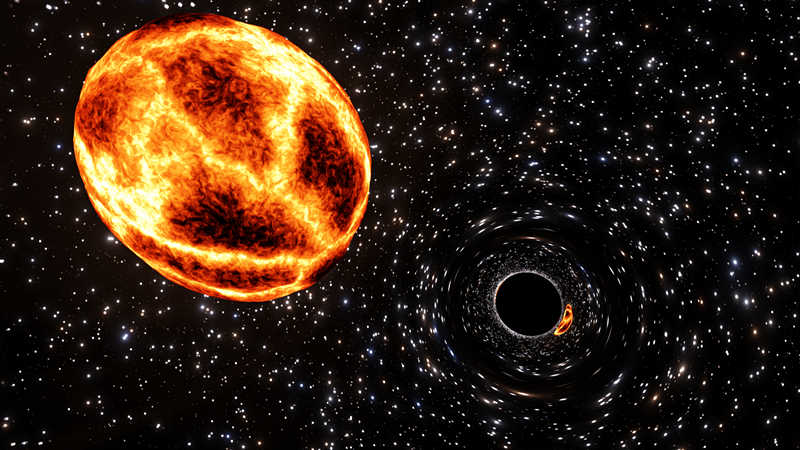
Apart from studying our own star system, we are also searching for another habitable planet within different star systems. However, even if we find such an Earth-like planet, we are still unable to conduct on-site investigations due to the nearest stars being approximately 4.22 light years away. Human-made spacecraft have yet to venture beyond the solar system. “Voyager 1” is a spacecraft launched by humanity several decades ago and is still hovering at the edge of the solar system. Clearly, our exploration of the cosmos has a long way to go.
In Conclusion
If humanity wishes to perpetuate its civilization, staying confined to Earth is not a viable long-term solution. Whether in terms of land area, resources, or lifespan, Earth will ultimately be insufficient to meet the needs of human civilization. Take energy, for example. Fossil fuels like oil, natural gas, and coal on Earth are finite, and the rate at which they are replenished cannot keep up with our consumption. Besides transitioning and reforming our energy use, we also need to expand outward, seeking more resources beyond Earth, even considering the possibility of interstellar migration.
Scientists have already begun to consider mining minerals on the Moon and some asteroids. However, it is challenging to find certain organic materials on lifeless celestial bodies. The question of whether we can find other planets with life or even advanced civilizations in the future is still unknown. For an ordinary person, the greatest hope is that our scientific and technological progress accelerates, allowing us to witness these developments during our lifetime and enjoy the conveniences brought by advanced technology.
More UFOs and mysterious files, please check out our YouTube channel: MysFiles
Is the moon artificial? Evidence Proves the Moon Was Unnaturally Formed
